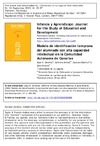Please use this identifier to cite or link to this item:
https://accedacris.ulpgc.es/jspui/handle/10553/72723
| Title: | Modelo de identificación temprana del alumnado con alta capacidad intelectual en la Comunidad Autónoma de Canarias | Other Titles: | Early identification model of high ability children in the Canary Islands | Authors: | Jiménez, Juan E. Artiles Hernández, Ceferino Ramírez, Gustavo Álvarez, Julio |
UNESCO Clasification: | 5802 Organización y planificación de la educación | Keywords: | Gifted High Ability Intelligence Parents' Perception Socio Economic Status, et al |
Issue Date: | 2004 | Journal: | International Journal of Phytoremediation | Abstract: | The early identification of gifted and talented students in the Canary Islands (Spain) was the purpose of the study. A random sample of 1,910 first year primary school students was selected from a population of 15,434 students using a stratified random sampling methodological procedure. The children came from different geographic areas (rural, rural-urban, urban, and tourist), socio-economic backgrounds, and schools (state and private). Intelligence tests, socio-metric tests and observation scales were administered to parents and teachers of students identified as high ability. According to the results, an 8.01% (N=153) of the students were identified as high ability (i.e., gifted and talented): 2.04% gifted, 1.21% simple talent, 1.89% as complex talent, and 2.89% mixed talent. To ascertain which questionnaires provided the most sensitive indicators of group membership (high ability students versus non-high ability students), discriminant function analyses were carried out. The first set of analyses showed that 71.4% of gifted cases could be correctly classified from teachers' perception, while the second set showed that parents' perception correctly classified 69.7% of gifted cases. Finally, socio-metric analysis showed that identified high ability students were neither referred as leaders or rejected by their peers. © 2004, Taylor and Francis Group, LLC. El principal objetivo de esta investigación consistió en la identificación temprana de alumnos con alta capacidad intelectual en la Comunidad Autónoma de Canarias. Para ello se llevó a cabo un muestreo aleatorio estratificado por afijación proporcional sobre una población de 15.434 alumnos de diferentes zonas geográficas, tipo de colegio y estratos socia les. Se seleccionó una muestra al azar de 1910 alumnos de primer curso de Educación Primaria y se administraron pruebas de inteligencia, cuestionario sociométrico y escalas de observación a padres y profesores sobre los alumnos identificados. e encontró un 8.01% (N = 153) de alumnos con excepcionalidad intelectual. De estos, un 2.04% se identificó con sobredotación intelectual, un 1.21% con talento simple, un 1.89% con talento complejo, y un 2.89% con talento mixto. Los hallazgos encontrados en el análisis discriminante demostraron que un 71.4% de los alumnos identificados con altas capacidades se clasificaban correctamente según la percepción de los profesores. En cambio, un 69.7% de los alumnos eran clasificados correctamente según la percepción de los padres. Finalmente, el análisis sociométrico demostró que los alumnos identificados con altas capacidades no presentaban características de liderazgo ni tampoco de rechazo social. |
URI: | https://accedacris.ulpgc.es/handle/10553/72723 | ISSN: | 0210-3702 | DOI: | 10.1174/0210370042396986 | Source: | Infancia y Aprendizaje: Journal for the Study of Education and Development [ISSN 0210-3702], v. 27 (4), p. 469-483 |
| Appears in Collections: | Artículos |
Items in accedaCRIS are protected by copyright, with all rights reserved, unless otherwise indicated.
